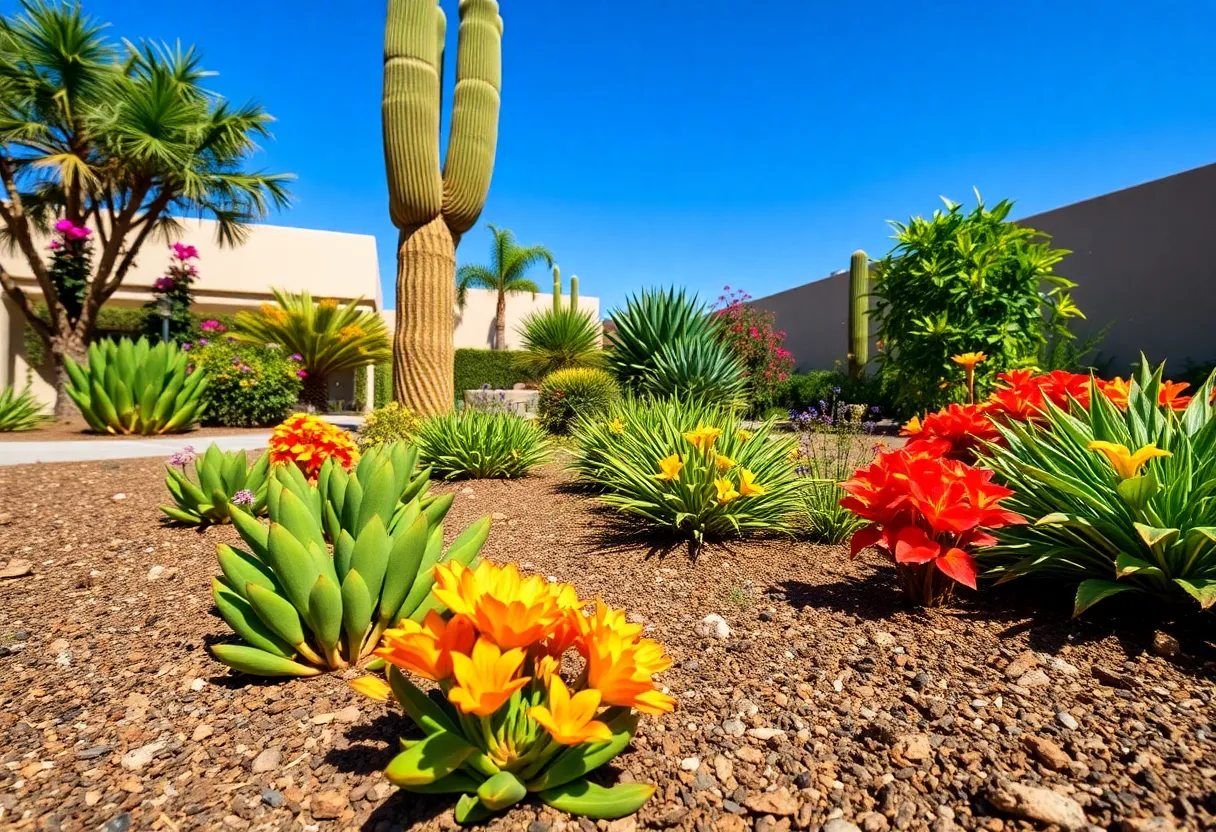10 Essential Tips for Watering Your Phoenix Garden Efficiently in an Arizona Drought
Gardening in Phoenix entails navigating an extremely arid climate that presents distinctive challenges, especially during drought periods. Implementing practices to optimize water use is essential for sustaining a healthy landscape while conserving scarce resources. Below are ten critical strategies to ensure that your garden remains vibrant and resilient despite water limitations.
1. Water Early in the Morning
Timing is crucial when watering in desert climates. Drawing water during early morning hours, typically between 4:00 a.m. and 6:00 a.m., results in maximum absorption and minimal evaporation. During these cooler, calmer conditions, water can seep deeper into the soil, reaching roots effectively. Conversely, watering during peak heat—between 10 a.m. and 4 p.m.—can cause rapid drying and *water wastage*. Proper scheduling ensures that plants receive essential moisture while reducing excess runoff.
2. Implement Drip Irrigation Systems
Drip irrigation delivers water directly to the root zone through a network of emitters. This targeted method minimizes both evaporation and runoff, making it significantly more efficient than traditional sprinkler setups. By promoting deep root growth, drip systems increase drought resilience. They can conserve up to 50% of water compared to spray-based methods, and they reduce the potential for overwatering, which can lead to plant stress and soil erosion.
3. Apply Organic Mulch Around Plants
Covering soil with organic mulch such as wood chips, straw, or bark creates a protective barrier. This layer significantly decreases soil moisture evaporation—by as much as 50%. Mulch also moderates soil temperature, suppresses weeds, and prevents surface compaction, all of which contribute to healthier root systems. Proper mulch application involves a layer 2-4 inches thick, ensuring moisture retention without suffocating plant roots.
4. Group Plants with Similar Water Needs Together
Implementing hydrozoning involves categorizing plants based on their water requirements. This strategy allows for tailored irrigation schedules—more frequent watering for high-demand plants and less for drought-tolerant species. Such segregation prevents the over- or underwatering of individual plants, optimizing water use across the landscape. Well-designed hydrozoning significantly reduces total water consumption while supporting plant health.
5. Water Deeply and Infrequently
Deep watering encourages plants to develop extensive root systems capable of accessing deeper moisture. This approach promotes drought tolerance and diminishes the need for frequent irrigation. For desert-adapted species, watering every 7-14 days—depending on soil and weather conditions—is usually sufficient once they are established. The goal is to mimic natural rainfall patterns, promoting resilient and sustainable plant growth.
6. Use Soaker Hoses for Garden Beds
Soaker hoses provide slow, consistent moisture directly into the soil along their length. This delivery reduces evaporation compared to spray systems and ensures even distribution of water across larger planting areas. Soaker hoses are especially effective for flower beds, vegetable patches, and shrub borders. An advantage is the ease of installation and adjustment, which promotes uniform plant hydration with minimal waste.
7. Monitor Soil Moisture Regularly
Regular soil moisture assessment is fundamental in avoiding over- or under-irrigation. Using a simple soil moisture meter or testing soil with your finger—a depth of 1-2 inches—provides immediate feedback on moisture levels. Water only when soil exhibits dryness; this prevents unnecessary water use and supports healthy root development. Consistent monitoring ensures irrigation is aligned with actual plant needs.
8. Choose Drought-Tolerant and Native Plants
Prioritizing drought-tolerant and native species is a strategic approach to minimize water requirements. These plants are naturally adapted to Phoenix’s climate and typically require minimal supplemental watering after establishment. Incorporating succulents, cacti, and native shrubs reduces dependency on irrigation, enhances landscape resilience, and preserves local biodiversity.
9. Install Smart Irrigation Controllers
Smart irrigation controllers utilize real-time weather data and soil conditions to dynamically adjust watering schedules. These devices optimize water use, reducing waste and ensuring plants receive adequate hydration—even during heatwaves. By automating the process, they prevent overwatering—saving up to 20% of water use—and improve landscape health in drought conditions.
10. Maintain Your Irrigation System Regularly
Consistent maintenance of your irrigation system is vital for efficiency. Regularly inspect for leaks, clogged emitters, and damaged components. Addressing issues promptly prevents water loss and ensures uniform distribution of moisture. Well-maintained systems operate at peak efficiency, directly translating into water conservation and healthier plants.
Conclusion
Effective watering in a Phoenix garden during drought demands deliberate strategies rooted in efficiency and sustainability. By adopting practices such as watering early, employing targeted irrigation, using mulch, grouping plants thoughtfully, and choosing native species, gardeners can significantly reduce water use without sacrificing landscape vitality. Regular system maintenance and leveraging technology further enhance conservation efforts. These measures not only protect water resources but also foster a resilient, thriving garden adapted to the challenging desert environment.
Frequently Asked Questions
What is the most water-efficient watering time for Phoenix gardens?
Early morning between 4:00 a.m. and 6:00 a.m. is ideal as it minimizes evaporation and allows water to penetrate deeply into the soil.
How does drip irrigation conserve water?
Drip irrigation provides targeted delivery directly at the root zone, reducing evaporation and runoff, thus using significantly less water than traditional sprinklers.
Why is mulching beneficial during droughts?
Mulch retains soil moisture, reduces evaporation, moderates soil temperature, and suppresses weeds, all of which help conserve water and promote healthier plants.
Can native plants help reduce water use?
Yes. Native plants are naturally adapted to desert conditions and typically require minimal supplemental watering once established, significantly lowering water demand.
How often should I water desert plants once they are established?
Deep watering every 7 to 14 days, depending on weather and soil conditions, is generally sufficient for drought-tolerant plants.
| Strategy | Benefit | Implementation Focus |
|---|---|---|
| Water early in the morning | Reduces evaporation; ensures deeper moisture absorption | Timing and schedule |
| Drip irrigation | Efficient delivery at root zone; conserves up to 50% | Targeted equipment installation | Mulch application | Retains soil moisture; suppresses weeds | Material selection and layering | Plant grouping | Optimizes water application; prevents over/underwatering | Landscape design | Deep, infrequent watering | Promotes drought-resistant roots | Scheduling and monitoring |
Author: STAFF HERE PHOENIX WRITER
The PHOENIX STAFF WRITER represents the experienced team at HEREPhoenix.com, your go-to source for actionable local news and information in Phoenix, Maricopa County, and beyond. Specializing in "news you can use," we cover essential topics like product reviews for personal and business needs, local business directories, politics, real estate trends, neighborhood insights, and state news affecting the area—with deep expertise drawn from years of dedicated reporting and strong community input, including local press releases and business updates. We deliver top reporting on high-value events such as the Waste Management Phoenix Open, Cactus League Spring Training, and Arizona State Fair. Our coverage extends to key organizations like the Greater Phoenix Chamber of Commerce and Visit Phoenix, plus leading businesses in technology and healthcare that power the local economy such as Intel and Banner Health. As part of the broader HERE network, including HERETucson.com, we provide comprehensive, credible insights into Arizona's dynamic landscape.





